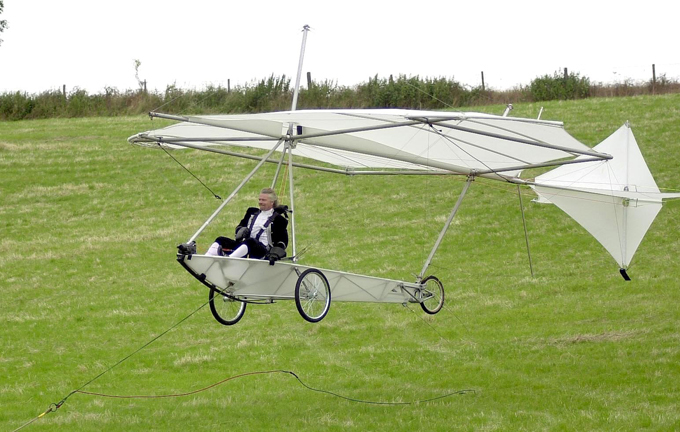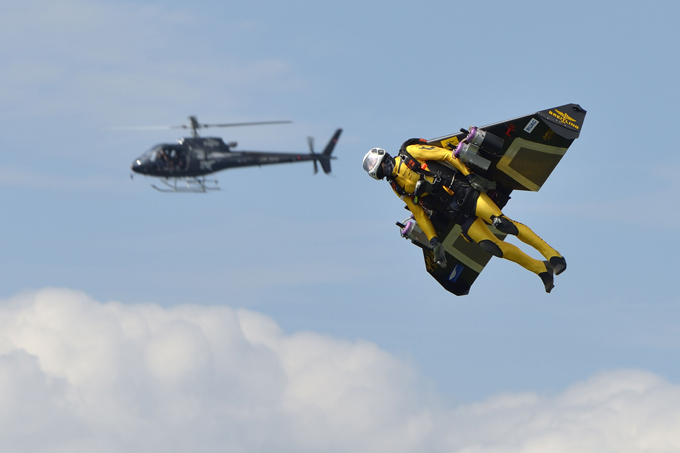People fly. They really do

Sir George Cayley, 6th Baronet (27 December 1773 - 15 December 1857) was a prolific English engineer and is one of the most important people in the history of aeronautics. Many consider him to be the first true scientific aerial investigator and the first person to understand the underlying principles and forces of flight.
Sir George Cayley, 6th Baronet (27 December 1773 - 15 December 1857) was a prolific English engineer and is one of the most important people in the history of aeronautics. Many consider him to be the first true scientific aerial investigator and the first person to understand the underlying principles and forces of flight.

The concept of jet pack emerged from science fiction in the 1920s and became popular in the 1960s as the technology became a reality. The most common use of the jet pack has been in extra-vehicular activities for astronauts
The concept of jet pack emerged from science fiction in the 1920s and became popular in the 1960s as the technology became a reality. The most common use of the jet pack has been in extra-vehicular activities for astronauts

Yves Rossy (born 27 August 1959) is a Swiss military-trained pilot and an aviation enthusiast. He is known as the inventor of a series of experimental individual jet packs, the latest using carbon-fiber wings for flight. Often referred to as "Jetman", Rossy has sometimes tested and presented new versions of his jet packs in high profile events staged around the world.
Yves Rossy (born 27 August 1959) is a Swiss military-trained pilot and an aviation enthusiast. He is known as the inventor of a series of experimental individual jet packs, the latest using carbon-fiber wings for flight. Often referred to as "Jetman", Rossy has sometimes tested and presented new versions of his jet packs in high profile events staged around the world.

The Puffin was a proposed hover-capable, electric-powered, low-noise, personal vertical takeoff and landing (VTOL) technology-concept proprotor aircraft. It was to be capable of flying a single person at a speed of 150 miles per hour (241 km/h). Range was projected to be less than 50 miles (80 km) with 2010-vintage Lithium-iron-phosphate battery technology.
The Puffin was a proposed hover-capable, electric-powered, low-noise, personal vertical takeoff and landing (VTOL) technology-concept proprotor aircraft. It was to be capable of flying a single person at a speed of 150 miles per hour (241 km/h). Range was projected to be less than 50 miles (80 km) with 2010-vintage Lithium-iron-phosphate battery technology.

Wingsuit flying (or wingsuiting) is the sport of flying through the air using a wingsuit, which adds surface area to the human body to enable a significant increase in lift. The modern wingsuit, first developed in the late 1990s, creates a surface area with fabric between the legs and under the arms. The wingsuit flier wears parachute equipment specially designed for skydiving or BASE jumping.
Wingsuit flying (or wingsuiting) is the sport of flying through the air using a wingsuit, which adds surface area to the human body to enable a significant increase in lift. The modern wingsuit, first developed in the late 1990s, creates a surface area with fabric between the legs and under the arms. The wingsuit flier wears parachute equipment specially designed for skydiving or BASE jumping.

The history of aviation has extended over more than two thousand years, from the earliest forms of aviation, kites and attempts at tower jumping, to supersonic, and hypersonic flight by powered, heavier-than-air jets.
The history of aviation has extended over more than two thousand years, from the earliest forms of aviation, kites and attempts at tower jumping, to supersonic, and hypersonic flight by powered, heavier-than-air jets.



